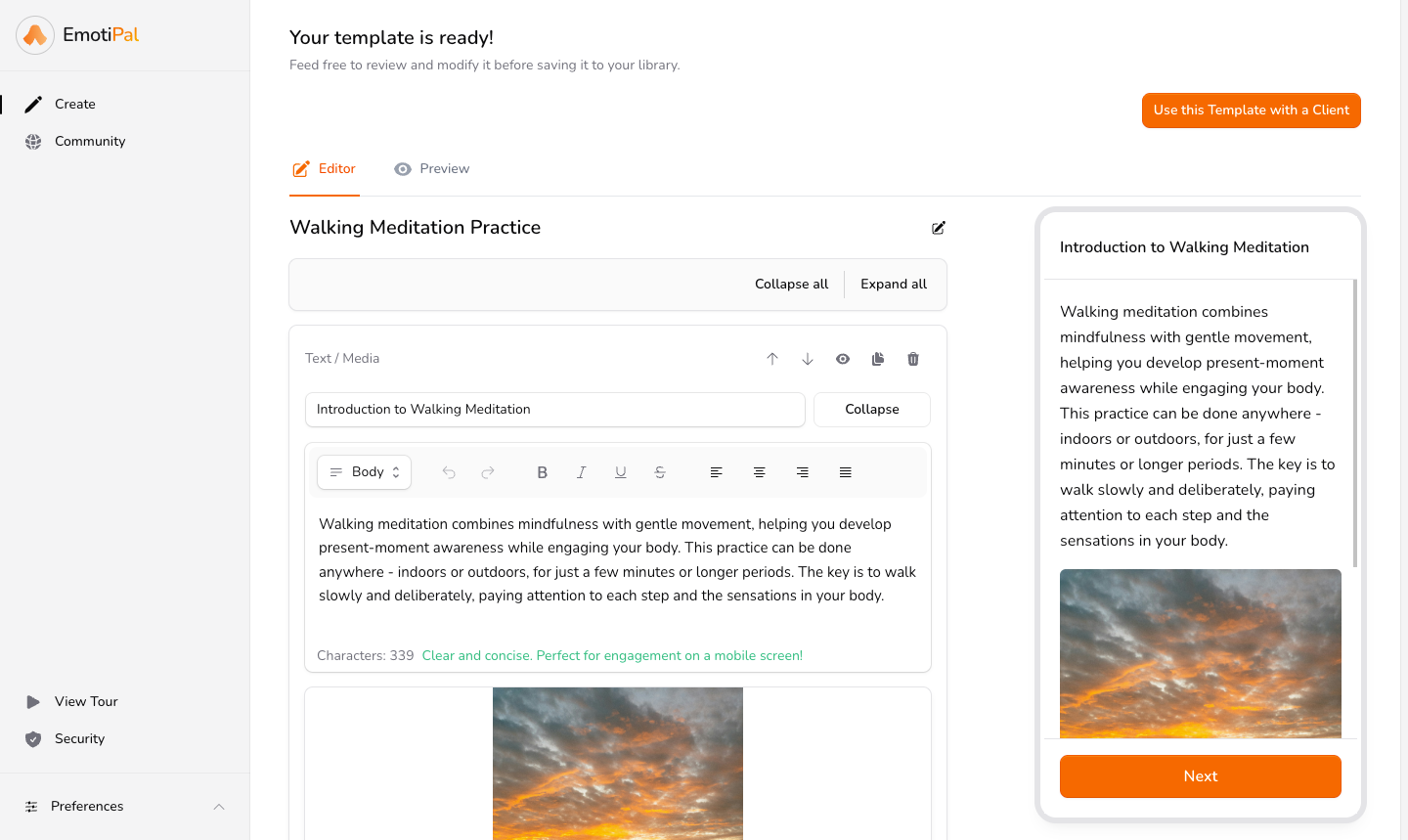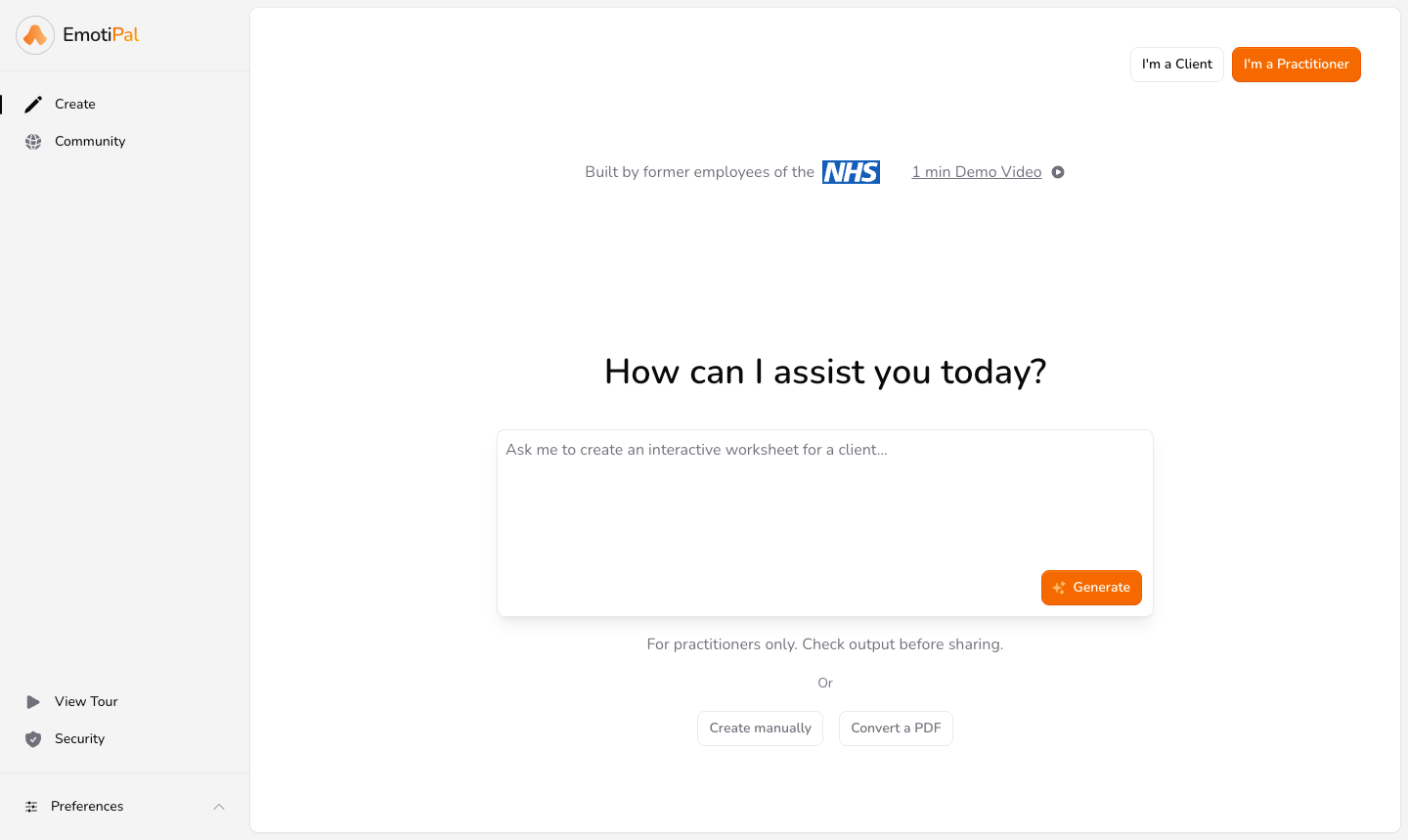
How EmotiPal effectively tackles barriers and supports homework task success as a therapy homework app
Summary
Psychotherapy homework is a crucial component of many evidence-based treatments. It helps clients apply skills and insights gained in therapy to their everyday lives, promoting lasting change. Homework bridges the gap between therapy sessions and real-world situations, reinforcing learning and promoting generalisation of skills.
However, many barriers exist to homework engagement, quality, and completion. By addressing key barriers and incorporating evidence-based strategies as a therapy homework app, Emotipal can significantly enhance client engagement, quality, and completion of psychotherapy homework. It provides a platform for therapists and clients to work together, creating clear, specific, personalised, and effective homework plans that promote therapeutic progress and lasting change.
Defining ‘Success’ in Psychotherapy Homework
There are various measures of homework ‘success’ other than ‘compliance’. Homework and quality and engagement, for example, are important. It is important to consider the term ‘engagement’ rather than ‘compliance’ as a more clinically meaningful construct. Compliance can suggest a passive following of instructions, while engagement implies an active and collaborative role in the homework process. Emotipal attempts to facilitate enhanced engagement and collaboration in psychotherapy homework design and completion.

Key challenges in therapy homework
Many barriers exist to homework engagement, quality, and completion.
1. Barriers to homework
Lack of Clarity and Specificity: Unclear Homework assignments, tasks that are overly-difficult, or not tied to specific situations are less likely to be completed.
Poor Rationale: Clients need to understand the purpose of the homework and how it relates to their therapy goals.
Lack of Collaboration: Homework that is not collaboratively developed between therapist and client can lead to resistance and poor engagement.
Negative Associations: The term “homework” itself can evoke negative reactions.
Client Beliefs: Clients’ beliefs about the task (e.g., difficulty, comprehension, match with goals) also influence homework engagement.
How EmotiPal can address homework barriers
The following features of EmotiPal can help minimise the impact of homework barriers.
Multimedia Options: therapists can include audio or video instructions and visual aids to enhance task understanding, especially for complex tasks.
Customisable Templates: Emotipal contains customisable templates, which can be useful in structuring tasks while maintaining flexibility for individual client circumstances.
Collaborative Task Design: Emotipal facilitates joint creation of homework tasks, allowing the therapist and client to set goals, plan actions, and review outcomes. This can promote a sense of ownership and increase client motivation.
Rationale and Goal Setting: Emotipal helps the therapist to clearly explain the rationale behind each task and how it aligns with the client’s therapy goals.
Anytime, Anywhere Access: The app provides clients with access to their homework assignments and instructions at any time and from any location.
Integration with Session Content: Therapists can more easily link key session content to homework assignments to increase relevance.
Mobile-Friendly Design: The app can be designed for various devices including tablets and mobile phones, allowing for ease of use.
2. Therapist Factors
Therapist competence in assigning and reviewing homework is an important factor for client engagement.
Choice of Tasks: Emotipal can include a library of different types of tasks, enabling therapists and clients to select the tasks most appropriate to their specific needs.
Easy Access to Information: Therapists can more easily access client progress and reports via the app, facilitating work conducted in session.
3. Importance of Quality
The quality of homework completion, including client skill acquisition and application of new strategies, is more predictive of positive outcomes than merely the quantity of homework completed.
Detailed Task Descriptions: The app makes it easy to provide detailed and specific task descriptions, including when, where, how often, and for how long the task should be carried out.
In-App Reporting: Emotipal allows clients to record their experiences with the homework tasks, including challenges they encountered and what they learned from the task.
Further research is needed to assess the impact of the Emotipal, and the use of such technology may further facilitate research in the area of homework in therapy.
References
- Fehm, L., & Kazantzis, N. (2004). Attitudes and use of homework assignments in therapy: A survey of German psychotherapists. Clinical Psychology & Psychotherapy, 11(5), 332–343.
- Garland, A. F., Brookman-Frazee, L., Hurlburt, M. S., & Baker-Ericzén, M. (2010). Mental health provider attitudes toward evidence-based practice. Child and Youth Care Forum, 39(2), 163–169.
- Jensen, A., Fee, C., Miles, A. L., Beckner, V. L., Owen, D., & Persons, J. B. (2020). Congruence of patient takeaways and homework assignment content predicts homework compliance in psychotherapy. Behavior Therapy, 51(3), 424-433.
- Jongsma, A. E., Jr. (2006). The adult psychotherapy homework planner. John Wiley & Sons.
- Kazantzis, N., Deane, F. P., & Ronan, K. R. (2000). The relationship between homework assignments and psychotherapy outcome: A meta-analysis. Clinical Psychology: Science and Practice, 7(2), 189–202.
- Kazantzis, N., & Ronan, K.R. (2004). Assessing homework compliance in psychotherapy: A critical review and recommendations for practice. Journal of Clinical Psychology, 60(6), 627–641.
- Kazantzis, N., Lampropoulos, G. K., & Deane, F. P. (2005). A national survey of practicing psychologists’ use and attitudes toward homework in psychotherapy. Journal of Consulting and Clinical Psychology, 73(4), 742–748.
- Kazantzis, N., & Ronan, K. R. (2006). Can between-session (homework) activities be considered a common factor in psychotherapy? Journal of Psychotherapy Integration, 16(2), 115–130.
- Kazantzis, N., Deane, F. P., & Ronan, K. R. (2007). Using homework assignments in cognitive behavior therapy. Routledge.
- Kazantzis, N., & Dattilio, F. M. (2010). Definitions of homework, types of homework, and ratings of the importance of homework among psychologists with cognitive behavior therapy and psychoanalytic theoretical orientations. Journal of Clinical Psychology, 66(7), 758–773.
- Kazantzis, N., Whittington, C., Zelencich, L., Norton, P. J., Kyrios, M., & Hofmann, S. G. (2016). Quantity and quality of homework compliance: A meta-analysis of relations with outcome in cognitive behavior therapy. Behavior Therapy, 47(5), 755–772.
- Kazantzis, N., & L’Abate, L. (2021). Using homework assignments in cognitive behavior therapy. Taylor & Francis.
- L’Abate, L., & DeJong, D. (2005). Reviewing 25 years of professional practice: Homework assignments and length. The American Journal of Family Therapy, 33(1), 19-31.
- Mausbach, B. T., Moore, R., Roesch, S., Cardenas, V., & Patterson, T. L. (2010). The relationship between homework compliance and therapy outcomes: An updated meta-analysis. Cognitive Therapy and Research, 34(6), 448–458.
- McDonald, K., & Morgan, R. D. (2013). Enhancing homework compliance in correctional psychotherapy. Criminal Justice and Behavior, 40(7), 810-828.
- Miller, J. J. (2010). Homework assignments in psychotherapy. (Unpublished doctoral dissertation). University of Wollongong.
- Nelson, K. J. (2011). The therapeutic alliance: The role of client attachment and client perception of the therapist’s interpersonal style (Doctoral dissertation).
- Ryum, T., Bennion, M., & Kazantzis, N. (2023a). Integrating between-session homework. In C. Hill & J. C. Norcross (Eds.), Psychotherapy methods and skills that work (pp. 247–280). Oxford.
- Ryum, T., Bennion, M., & Kazantzis, N. (2023b). Integrating between-session homework in psychotherapy: A systematic review of immediate in-session and intermediate outcomes. Psychotherapy, 60(3), 306–319.
- Ryum, T., & Kazantzis, N. (2024). Between‐session homework in clinical training and practice: A transtheoretical perspective. Clinical Psychology in Europe, 6(1), 1-26.
- Scheel, M. J., Hanson, W. E., & Razzhavaikina, T. I. (2004). The process of recommending homework in psychotherapy: A review of therapist delivery methods, client acceptability, and factors that affect compliance. Psychotherapy: Theory, Research, Practice, Training, 41(1), 38–55.
- Stewart, J., Simpson, J., & Smith, E. (2015). The intersession experience: A systematic review of the patient’s perspective of what happens in between therapy sessions. Psychotherapy Research, 25(5), 509-522.
- Kazantzis, N., & Dattilio, F. M., Cummins, A., & Clayton, X. (2013). Homework assignments and self-monitoring. In S. G. Hofman, D. J. A. Dozois, W. Rief, & J. Smits (Eds.), The Wiley handbook of cognitive behavioral therapy (Vol. 1, pp. 311-330). John Wiley & Sons.
- Kazantzis, N., Whittington, C. J., & Dattilio, F. M. (2010c). Meta-analysis of homework effects in cognitive and behavioral therapy: A replication and extension. Clinical Psychology: Science and Practice, 17, 144–156.
